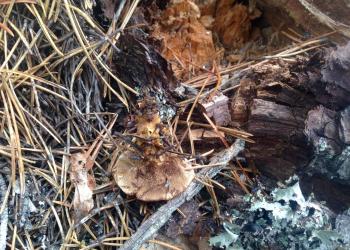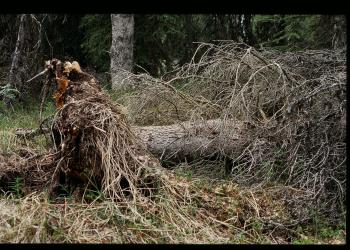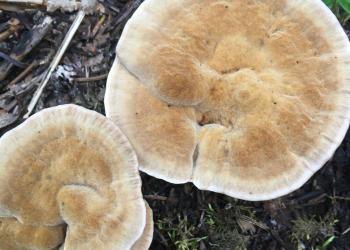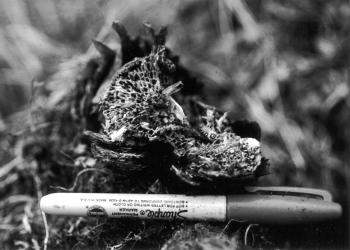Tomentosus Root Rot
Onnia tomentosa (Fr.) P. Karst. (=Inonotus tomentosus)
Hosts in Alaska:
Primarily white and black spruce (Picea glauca and P. mariana),
but also Sitka spruce (P. sitchensis), lodgepole pine (Pinus contorta) and eastern larch (Larix larisona)
General Distribution in Alaska: Most common in Southcentral and Interior Alaska
Onnia was consistently observed in association with dead and dying spruce in Southcentral Alaska, often seen fruiting on the infected roots. Our specimens contributed to ongoing work to better understand the Onnia species and host diversity in North America, and were sent to Dr. Patrick Bennett (Rocky Mountain Research Station) and Dr. Jane Stewart’s (Colorado State University) Lab. Southeast Alaska is on the lookout for another Onnia sp. on shore pine, recognizable by its curved hymenial setae, which contrast with the straight setae of Onnia tomentosa.
2024 Ground Detection Survey Observations: 7 observations on white and black spruce, most around Anchorage, and one south of Talkeetna.
2024 iNaturalist Observations: 6 research grade observations, 2 from the coastal Southeast, and 4 in Southcentral.
The common name for this pathogen’s fruiting body is the wooly velvet polypore. Fruiting bodies are usually attached directly to rotting tree roots. Observations of this fungus span Interior, Southcentral, and parts of Southeast Alaska (see Detection Map). Since O. tomentosa produces fruiting structures that are both uncommon and ephemeral, iNaturalist observations enhance our understanding of this pathogen’s distribution in Alaska.
Annual fruiting bodies are produced in the late-summer and fall, developing on the ground near the base of infected trees. Fruiting bodies are leathery and small (usually less than 4 inches in diameter), and often have leaf litter embedded in them.The upper surface is distinctly felty, yellow-brown to rusty-brown with a blunt, rounded, yellowish-white margin. The lower surface is cream to yellow-brown with small round pores that extend part way down the thick central stalk. There is often brown felt along the portion of the stalk closest to the ground. The incipient/early stage of root decay is characterized by a red-brown to pink stain in the heartwood. Wood with latent/advanced decay contains elongated spindle shaped pits, with poorly defined margins, separated by red-brown firm wood. The cross section of infected roots with advanced white pocket rot decay appears honeycombed. Stump surfaces of infected trees often exhibit stain and honeycombing.
Damage includes outright mortality, butt decay of up to one third of the gross volume, premature uprooting from loss of structural roots, and growth reduction. Host trees are susceptible to infection at any age. The fungus efficiently spreads through root contacts between infected and healthy roots, thus diseased trees occur in groups and mortality results in stand openings. Following death of an infected tree, the fungus may remain alive for decades. Spruce trees planted or growing within active tomentosus root rot centers become infected through root contact with diseased stumps/roots and may be killed outright.
Avoid planting spruce trees in root disease centers as infected stumps and roots serve as inoculum sources for succeeding generations of spruce trees. Losses can be mitigated by establishing less susceptible species (e.g., hardwoods) on infected sites, and planting susceptible species (e.g., spruce) at least 3 meters from known inoculum sources. Thinning infected stands may increase the incidence and damage of this root disease. Careful diagnosis through root inspection is important because advanced decay can be mistaken for other pocket rots, particularly Porodaedalea pini. Canada’s neighboring Yukon Territory has conducted limited surveys that suggest more than 40% of trees were infected. This root disease can be very difficult to diagnose, especially because conks are often absent. The causal fungus was formerly known as Inonotus tomentosus.
Hunt, R.S., White, T. 1998. First Report of Inonotus tomentosus, the Cause of Tomentosus Root Disease, from the Yukon Territory. Plant Dis. 82(2):264. Available here.
Lee et al. 2024. Association of Onnia subtriquetra with living and dead bishop pine (Pinus muricata) and shore pine (Pinus contorta var. contorta) in California, USA. Forest Pathology. https://doi.org/10.1111/efp.12844
Lewis. K.J. 1997. Growth reduction in spruce infected by Inonotus tomentosus in central British Columbia. Can. J. For. Res. 27: 1669–1674. Available here.
Lewis, K.J. and B.S. Lindgren. 2002. Relationship between spruce beetle and tomentosus root disease: two natural disturbance agents of spruce. Can. J. of For. Res. 32:31–37. Available here.
Lewis, K.J., Trummer, L.M. and R.D. Thompson. 2004. Incidence of tomentosus root disease relative to spruce density and slope position in south-central Alaska. Forest Ecology and Management 194(1–3):159–167. Available here.
Lewis, K.J., Thompson, R.D., and L. Trummer B.S. 2005. Growth response of spruce infected by Inonotus tomentosus in Alaska and interactions with spruce beetle. Can. J. of For. Res. 35:1455–1463. Available here.
Reich, R. and K.J. Lewis. 2013. Tomentosus Root Rot Forest Health Stand Establishment Decision Aid. Journal of Ecosystems and Management 14(1): 8pp. Available here.
Trummer, L.M. 1999. Tomentosus Root Rot Alaska Forest Health Leaflet. R10-TP-80. Available here.
Content prepared by Robin Mulvey, Forest Pathologist, Forest Health Protection, robin.mulvey@usda.gov


















